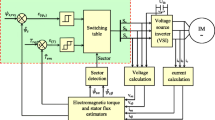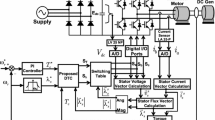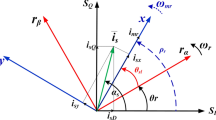Abstract
To elucidate the principles of notable torque and flux ripple during the steady state of the conventional direct torque control (DTC) of induction machines, the factors of influence torque variation are examined. A new torque ripple minimization algorithm is proposed. The novel method eradicated the torque ripple by imposing the required stator voltage vector in each control cycle. The M and T axial components of the stator voltage are accomplished by measuring the stator flux error and the expected incremental value of the torque at every sampling time. The maximum angle rotation allowed is obtained. Experimental results showed that the proposed method combined with the space vector pulse width modulation (SVPWM) could be implemented in most existing digital drive controllers, offering high performance in both steady and transient states of the induction drives at full speed range. The result of the present work implies that torque fluctuation could be eliminated by imposing proper stator voltage, and the proposed scheme could not only maintain constant switching frequency for the inverter, but also solve the heating problem and current harmonics in traditional induction motor drives.
Similar content being viewed by others
References
Ohtani T, Takada N, Tanaka K. Vector control of induction motor without shaft encoder [J]. IEEE Transactions on Industry Applications, 1992, 28(1): 157–164.
Schauder C. Adaptive speed identification for vector control of induction motors without rotational transducers [J]. IEEE Transactions on Industry Applications, 1992, 28(5): 493–499.
Tripathi A, Khambadkone A M, Panda S K. Dynamic control of torque in overmodulation and in the field weakening region [J]. IEEE Transactions on Power Electronics, 2006, 21(4): 1091–1098.
Campbell J A, Sumnor M, Curtis M. An improved sensorless vector controlled induction motor drive employing artificial neural networks for stator resistance estimation [C]// 8th International Conferences on Power Electronics and Variable Speed Drives, London. 2000: 274–279.
Chen M, Chen M. Speed sensorless vector control of induction motor using kalman filter assisted adaptive observer [J]. IEEE Transactions on Industrial Applications, 1999, 45(2): 359–361.
Peng F Z, Fukao T. Robust speed identification for speed-sensorless vector control of induction motors [J]. IEEE Transactions on Industrial Applications, 1994, 30(5): 1234–1240.
Doki S, Sangwongwanich S, Okuma S. Implementation of speed-sensorless field-oriented vector control using adaptive sliding observer [C]// Proceedings of the 1992 International Conference on Industrial Electronics, Control, Instrumentation, and Automation, San Diego, California, USA. Piscataway, NJ: IEEE Press, 1992, 1: 453–458.
Vaez-Zadeh S, Jalali E. Combined vector control and direct torque control method for high performance induction motor drives [J]. Energy Conversion and Management, 2007, 48(12): 3095–3101.
Yang W Q, Jia Z C, Xu Q. Speed sensorless vector control of induction motor based on reduced order extended Kalman filter [J]. Journal of Southeast University (English Edition), 2001, 17(1): 41–45.
Young-Real K. Speed sensorless vector control of induction motor using extended kalman filter [J]. IEEE Transactions on Industrial Applications, 1994, 30(5): 1225–1233.
Habetler T G, Profmno F, Pastorelli M, et al. Direct torque control of induction machines using space vector modulation [J]. IEEE Transactions on Industrial Applications, 1992, 28(5): 1045–1053.
Depenbrock M. Direct self-control (DSC) of inverterfed induction machine [J]. IEEE Transactions on Power Electronics, 1988, 3(4): 420–428.
Jun-koo K, Seung-ki S. Torque ripple control and current limitation method in start-up of an induction machines [C]// Proceedings of the IEEE Conference on Power Electronics and Variable Speed Drives, England. 1998: 451–455.
Trondheim F, Flach R H, Mutschler P. Direct mean torque of an induction machine [C]// Proceedings of the 7th European Conference on Power Electronics and Applications, Morelos. 1997, 3: 672–677.
Jun-koo K, Seung-ki S. New direct torque control of induction motor for minimum ripple and constant switching frequency [J]. IEEE Transactions on Industrial Application, 1999, 35(5): 1076–1082.
Qiang D X, Ma X N, Hu X R. The fuzzy direct torque control of induction motor based on space vector modulation [C]// Proceedings of the Third International Conference on Natural Computation, Haikou, China. Washington DC, USA: IEEE Computer Society, 2007, 4(24–27): 260–264.
Yang X, Oghanna W. Fuzzy direct torque control of induction motor with stator flux estimation compensation [C]//23rd International Conference on Industrial Electronics, Control and Instrumentation, New Orleans, LA, USA. 1997, 2(9–14): 505–510.
Chen L, Fang K L, Hu Z F. A scheme of fuzzy direct torque control for induction machine [C]//Proceedings of 2005 International Conference on Machine Learning and Cybernetics, Guangzhou, China. 2005, 2: 803–807.
Perantzakis G S, Xepapas F H, Manias S N. Efficient predictive current control technique for multilevel voltage source inverters [C]//European Conference on Power Electronics and Applications, Dresden. 2005: 11–14.
Antoni Arias L R, Emiliano Aldabas, Marcel Jayne. Stator flux optimised direct torque control system for induction motors [J]. Electric Power Systems Research, 2005, 73(3): 257–265.
Sahoo SKP N C, Dash P K. A current modulation scheme for direct torque control of switched reluctance motor using fuzzy logic [J]. Mechatronics, 2000, 10(3): 353–370.
Sheidaei F S, Mohseni-Zonoozi M, Alinejad-Beromi Y S H. A fuzzy logic direct torque control for induction motor sensorless drive [C]//42nd International Universities Power Engineering Conference, Brighton. 2007: 197–202.
Arias A, Romeral J L, Aldabas E, Jayne M G. Fuzzy logic direct torque control [C]//Proceedings of the 2000 IEEE International Symposium on Industrial Electronics, Cholula, Puebla, Mexico. 2000, 1(4–8): 253–258.
Zhang Y W, Gui W H. Compensation for secondary uncertainty in electro-hydraulic servo system by gain adaptive sliding mode variable structure control [J]. Journal of Central South University of Technology (English Edition), 2008, 15(2): 256–263.
Author information
Authors and Affiliations
Corresponding author
Additional information
Project supported by the National Natural Science Foundation of China (Grant No.2004EA105003)
About this article
Cite this article
Long, B., Guo, Gf., Hao, Xh. et al. Novel torque ripple minimization algorithm for direct torque control of induction motor drive. J. Shanghai Univ.(Engl. Ed.) 13, 155–163 (2009). https://doi.org/10.1007/s11741-009-0213-3
Received:
Revised:
Published:
Issue Date:
DOI: https://doi.org/10.1007/s11741-009-0213-3




